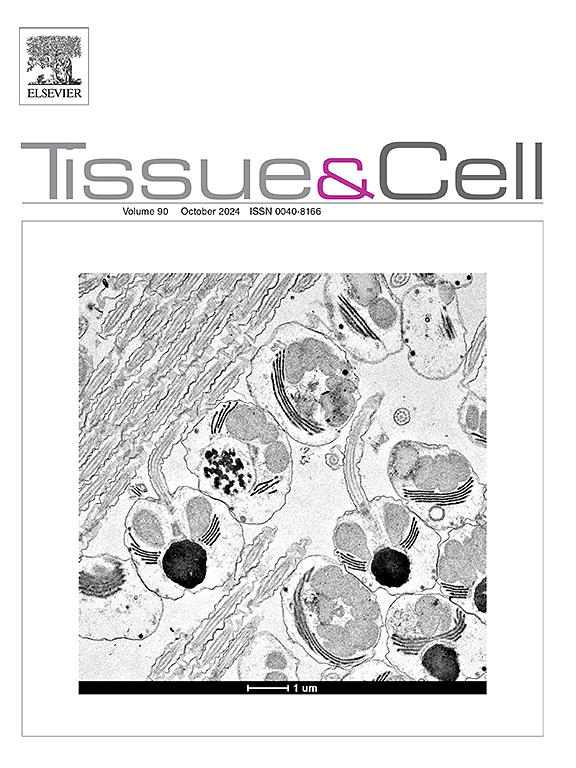油酸通过S100A9-HK2/PKM2-SOD2信号通路抑制高糖条件下舌鳞癌细胞的增殖、侵袭和迁移
IF 2.7
4区 生物学
Q1 ANATOMY & MORPHOLOGY
引用次数: 0
摘要
舌鳞状细胞癌(TSCC)的发病率逐年上升。2型糖尿病(T2DM)是TSCC的危险因素之一,高血糖是T2DM的标志,可促进口腔癌的发展,并导致伴有T2DM的TSCC患者预后较差。油酸(OA)是鸦鸦油乳剂的主要成分,具有抗癌和抗糖尿病的双重作用。然而,高糖条件下OA对舌鳞状细胞癌(TSCC)的精确调控机制尚未完全阐明。我们的研究结果表明,高葡萄糖显著增强了TSCC细胞的迁移、侵袭和增殖能力。值得注意的是,OA治疗有效地逆转了高糖诱导的TSCC细胞活性增强。此外,我们的研究发现OA通过稳定其与S100A9的结合来调节糖酵解途径,从而发挥其抗肿瘤作用。最终,我们证实OA在TSCC合并T2DM患者中的抗肿瘤机制与S100A9-HK2/PKM2-SOD2通路失活有关。综上所述,OA通过调控S100A9-HK2/PKM2-SOD2通路抑制高糖条件下TSCC细胞的增殖、迁移和侵袭。本文章由计算机程序翻译,如有差异,请以英文原文为准。
Oleic acid inhibits the proliferation, invasion, and migration of tongue squamous cell carcinoma cells under high glucose conditions through S100A9-HK2/PKM2-SOD2 signaling pathway
The incidence of tongue squamous cell carcinoma (TSCC) has been increasing annually. Type 2 diabetes mellitus (T2DM) is one of the risk factors for TSCC, with hyperglycemia being a hallmark of T2DM that promotes the development of oral cancer and results in poorer prognoses for TSCC patients who also have T2DM. Oleic acid (OA), a component of Brucea javanica oil emulsion, exhibits both anti-cancer and anti-diabetic properties. However, the precise regulatory mechanisms of OA on tongue squamous cell carcinoma (TSCC) under high glucose conditions have yet to be fully elucidated. Our findings demonstrated that high glucose significantly enhanced the migratory, invasive, and proliferative capabilities of TSCC cells. Notably, OA treatment effectively reversed these high glucose-induced enhancements in TSCC cellular activities. Furthermore, our research revealed that OA exerted its anti-tumor effects by stabilizing its binding with S100A9, which modulated the glycolytic pathway. Ultimately, we confirmed that the anti-tumor mechanism of OA in TSCC patients with T2DM was associated with the inactivation of the S100A9-HK2/PKM2-SOD2 pathway. In summary, OA inhibited the proliferation, migration, and invasion of TSCC cells under high glucose conditions through the regulation of the S100A9-HK2/PKM2-SOD2 pathway.
求助全文
通过发布文献求助,成功后即可免费获取论文全文。
去求助
来源期刊

Tissue & cell
医学-解剖学与形态学
CiteScore
3.90
自引率
0.00%
发文量
234
期刊介绍:
Tissue and Cell is devoted to original research on the organization of cells, subcellular and extracellular components at all levels, including the grouping and interrelations of cells in tissues and organs. The journal encourages submission of ultrastructural studies that provide novel insights into structure, function and physiology of cells and tissues, in health and disease. Bioengineering and stem cells studies focused on the description of morphological and/or histological data are also welcomed.
Studies investigating the effect of compounds and/or substances on structure of cells and tissues are generally outside the scope of this journal. For consideration, studies should contain a clear rationale on the use of (a) given substance(s), have a compelling morphological and structural focus and present novel incremental findings from previous literature.
 求助内容:
求助内容: 应助结果提醒方式:
应助结果提醒方式:


